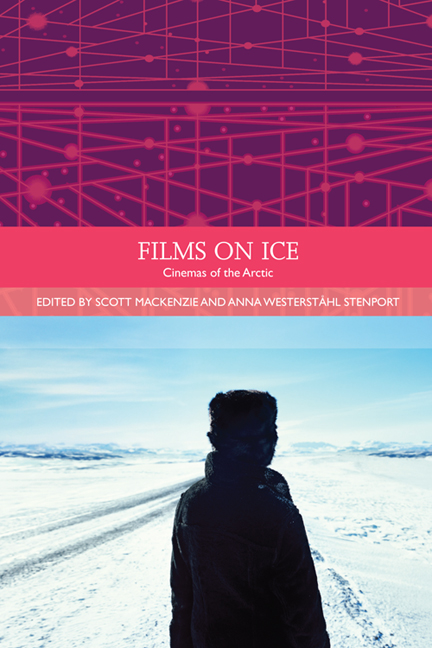Book contents
- Frontmatter
- Contents
- List of Illustrations
- Acknowledgements
- Traditions in World Cinema
- Introduction: What are Arctic Cinemas?
- PART I GLOBAL INDIGENEITY
- PART II HOLLYWOOD HEGEMONY
- PART III ETHNOGRAPHY AND THE DOCUMENTARY DILEMMA
- PART IV MYTHS AND MODES OF EXPLORATION
- 20 The Changing Polar Films: Silent Films from Arctic Exploration 1900–30
- 21 The Attractions of the North: Early Film Expeditions to the Exotic Snowscape
- 22 Frozen in Motion: Ethnographic Representation in Donald B. MacMillan's Arctic Films
- 23 ‘My Heart Beat for the Wilderness’: Isobel Wylie Hutchison, Jenny Gilbertson, Margaret Tait and Other Twentieth-Century Scottish Women Filmmakers
- 24 ‘Here will be a Garden-City’: Soviet Man on an Arctic Construction Site
- 25 Transcending the Sublime: Arctic Creolisation in the Works of Isaac Julien and John Akomfrah
- 26 DJ Spooky and Dziga Vertov: Experimental Cinema Meets Digital Art in Exploring the Polar Regions
- Notes on the Contributors
- Index
20 - The Changing Polar Films: Silent Films from Arctic Exploration 1900–30
from PART IV - MYTHS AND MODES OF EXPLORATION
Published online by Cambridge University Press: 05 September 2016
- Frontmatter
- Contents
- List of Illustrations
- Acknowledgements
- Traditions in World Cinema
- Introduction: What are Arctic Cinemas?
- PART I GLOBAL INDIGENEITY
- PART II HOLLYWOOD HEGEMONY
- PART III ETHNOGRAPHY AND THE DOCUMENTARY DILEMMA
- PART IV MYTHS AND MODES OF EXPLORATION
- 20 The Changing Polar Films: Silent Films from Arctic Exploration 1900–30
- 21 The Attractions of the North: Early Film Expeditions to the Exotic Snowscape
- 22 Frozen in Motion: Ethnographic Representation in Donald B. MacMillan's Arctic Films
- 23 ‘My Heart Beat for the Wilderness’: Isobel Wylie Hutchison, Jenny Gilbertson, Margaret Tait and Other Twentieth-Century Scottish Women Filmmakers
- 24 ‘Here will be a Garden-City’: Soviet Man on an Arctic Construction Site
- 25 Transcending the Sublime: Arctic Creolisation in the Works of Isaac Julien and John Akomfrah
- 26 DJ Spooky and Dziga Vertov: Experimental Cinema Meets Digital Art in Exploring the Polar Regions
- Notes on the Contributors
- Index
Summary
The Heroic Era of polar exploration – roughly from the 1890s to the death of Sir Ernest Shackleton in the early 1920s – produced many fascinating stories about remarkable men. The races to the Poles are richly described in hundreds of books, but this era also coincided with the development of film technology and the rise of commercial cinema. Many polar explorers saw potential in using this new technology as a research tool, and their sponsors saw the huge entertainment value of such recordings. As a result, a range of films from the polar expeditions of this era was created. Aside from some of the featurelength titles from Antarctica, such as Herbert Ponting's Great White Silence (UK, 1924) and Frank Hurley's South (UK, 1919), the polar films as a subgenre have received little attention compared with the written accounts. The as-yet-unwritten story of these films is a rewarding one, with much to tell us not only about the extraordinary achievements of the first polar explorers and their pioneering cameramen, but also about the development of filmmaking and the cinema, and even the tastes of audiences and the fortunes of empires and nation-states.
With the advent of the aeroplane, the airship and the telegraph, the Mechanical Era of polar exploration had arrived. The Norwegian explorer Roald Amundsen played a major role in the development of this era; he claimed his use of aeroplanes was as important to the progress of polar exploration as his countryman Fridtjof Nansen's use of skis and dog sledges had been in the Heroic Era. Also during this period, the documentary film became a popular genre as a result of films such as Nanook of the North (Robert Flaherty, USA, 1922), Grass (Merian C. Cooper and Ernest B. Schoedsack, USA, 1925) and Osa and Martin Johnson's many safari documentaries. Newsreels also became popular, and many film companies around the world competed to get the best news items for their weekly news reviews. There were many such films from the Arctic in this period. The following examples illustrate how the explorers’ motives for bringing a film camera changed, and also how polar expeditions became media events when distributed through the cinemas, and as constitutive features of early twentieth-century press and news media culture.
- Type
- Chapter
- Information
- Films on IceCinemas of the Arctic, pp. 265 - 278Publisher: Edinburgh University PressPrint publication year: 2014



